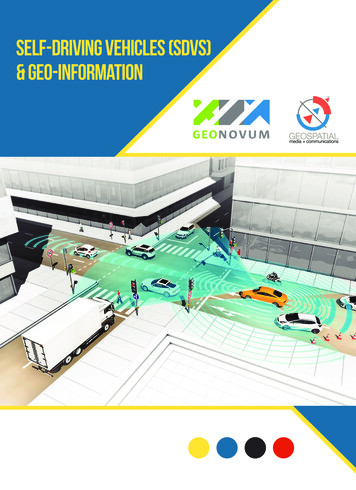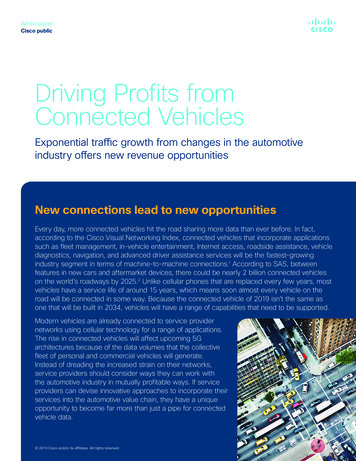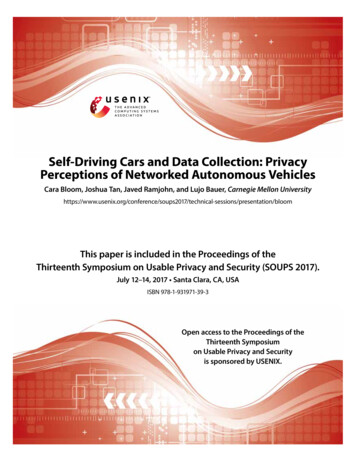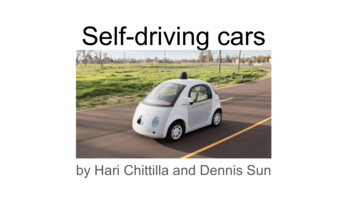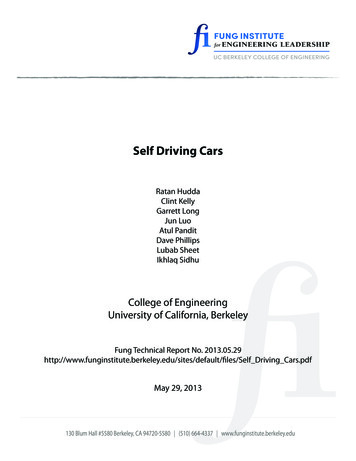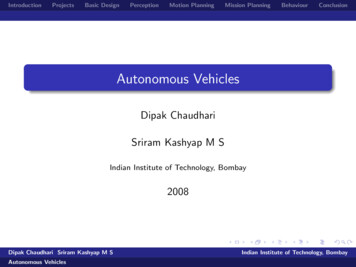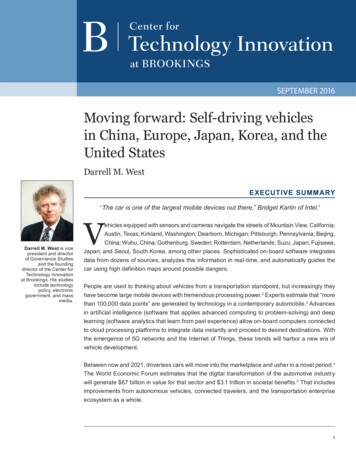
Transcription
SEPTEMBER 2016Moving forward: Self-driving vehiclesin China, Europe, Japan, Korea, and theUnited StatesDarrell M. WestEXECUTIVE SUMMARY“The car is one of the largest mobile devices out there,” Bridget Karlin of Intel.1Darrell M. West is vicepresident and directorof Governance Studiesand the foundingdirector of the Center forTechnology Innovationat Brookings. His studiesinclude technologypolicy, electronicgovernment, and massmedia.Vehicles equipped with sensors and cameras navigate the streets of Mountain View, California;Austin, Texas; Kirkland, Washington; Dearborn, Michigan; Pittsburgh, Pennsylvania; Beijing,China; Wuhu, China; Gothenburg, Sweden; Rotterdam, Netherlands; Suzu, Japan; Fujisawa,Japan; and Seoul, South Korea, among other places. Sophisticated on-board software integratesdata from dozens of sources, analyzes this information in real-time, and automatically guides thecar using high definition maps around possible dangers.People are used to thinking about vehicles from a transportation standpoint, but increasingly theyhave become large mobile devices with tremendous processing power.2 Experts estimate that “morethan 100,000 data points” are generated by technology in a contemporary automobile.3 Advancesin artificial intelligence (software that applies advanced computing to problem-solving) and deeplearning (software analytics that learn from past experience) allow on-board computers connectedto cloud processing platforms to integrate data instantly and proceed to desired destinations. Withthe emergence of 5G networks and the Internet of Things, these trends will harbor a new era ofvehicle development.Between now and 2021, driverless cars will move into the marketplace and usher in a novel period.4The World Economic Forum estimates that the digital transformation of the automotive industrywill generate 67 billion in value for that sector and 3.1 trillion in societal benefits.5 That includesimprovements from autonomous vehicles, connected travelers, and the transportation enterpriseecosystem as a whole.1
This paper looks at different types of autonomous vehicles, shows their potential impact, and discusses the budgetary, policy, and regulatory issues raised by driverless cars and trucks. It argues that connected vehicles arelikely to improve highway safety, alleviate traffic congestion, and reduce air pollution. However, to do that, designersmust overcome obstacles such as poor infrastructure,bad weather, inadequate spectrum, hacking threats, andPeople are used to thinking aboutpublic acceptance.vehicles from a transportationstandpoint, but increasingly theyhave become large mobile deviceswith tremendous processing power.The technology to meet these barriers has advancedrapidly and is poised for commercial deployment. But tomake progress, each country needs to address particularissues. There are budgetary, policy, legal, and regulatoryconcerns to resolve.In China, for example, the key is to develop a national policy framework for autonomous vehicles. It has multipleministries which are responsible for the supervision of automatic driving (some with overlapping jurisdictions) andthere needs to be greater clarity regarding who regulates and how they regulate. In addition, the government needsto invest in highway infrastructure for autonomous vehicles, eliminate the current national prohibition on road testing,and reduce restrictions on road map development so that car makers and software designers can devise the mostaccurate navigational guides.In Europe, the challenge is strengthening the artificial intelligence capability that is crucial to autonomous vehicles.One of the reasons why large technology firms such as Google in the United States and Baidu in China have movedinto transportation is the opportunity to apply the processing insights and rapid learning capacity developed throughsearch engine technology to a new sector. To be competitive in driverless vehicles, European auto manufacturerssuch as Audi, BMW (in collaboration with Intel), Volkswagen, Daimler, Mercedes-Benz, and Volvo need people withstrong artificial intelligence skills and high performance computing aptitude because car manufacturing no longeris about physical design as much as it is about software development and real-time data analytics. The EuropeanUnion also needs to make sure that its data protection rules don’t place overly-strict limitations on the analysis ofpeople’s movement and location because that information is vital to high definition mapping for autonomous vehicles.In Japan and Korea, governments and car manufacturers have been cautious about autonomous vehicles. Firmssuch as Toyota, Honda, Nissan, Kia, and Hyundai are investing major resources. They are keeping track of what ishappening in other countries and undertaking pilot projects. Yet they have to decide whether autonomous vehiclesrepresent a high priority for them. If so, they should invest resources in artificial intelligence, high definition mapping,and data analytics, which are key to the future of this sector. Failure to do so means they will be left behind as theindustry embraces autonomous vehicles in the coming years.In the United States, the major difficulty is overcoming the regulatory fragmentation caused by 50 states havingdiffering preferences on licensing, car standards, regulation, and privacy protection. Right now, car manufacturers(such as Ford and General Motors) and software developers face conflicting rules and regulations in various states.6This complicates innovation because makers want to build cars and trucks for a national or international market.There also needs to be greater clarity in regard to legal liability and data protection, and legislation to penalize themalicious disruption of autonomous vehicles.Moving forward: Self-driving vehicles in China, Europe,Japan, Korea, and the United States 2
In each nation, government officials and business leaders have to resolve these matters because within a foreseeable period, the technology will have advanced to the point where intelligent vehicles will spread into key nichessuch as ride-sharing, taxis, delivery truck, industrial applications, and transport for senior citizens and the disabled.People and businesses will have driverless options for taking them safely to their destinations, and it is importantfor leaders to provide reasonable guidance on how to commercialize advanced technologies in transportation.THE IMPORTANCE OF ARTIFICIAL INTELLIGENCE, HIGHDEFINITION MAPS, AND DEEP LEARNING TO AUTONOMOUSVEHICLESAutonomous vehicles involve the application of advanced technological capabilities to cars, trucks, and buses.This includes automated vehicle guidance and braking, lane-changing systems, use of cameras and sensors forcollision avoidance, artificial intelligence to analyze information in real-time, and high performance computing anddeep learning systems to adapt to new circumstances through 3D high definition maps.Light detection and ranging systems (known as LiDARs) and artificial intelligence are key to navigation and collision avoidance. The former are a combination of light and radar instruments mounted on the top of vehicles thatuse imaging in a 360-degree environment from a radar and light beams to measure the speed and distance of surrounding objects. Along with sensors placed along the front, sides, and back of vehicles, these instruments provideinformation that keeps fast-moving cars and trucks in their own lane, avoids other vehicles, applies brakes andsteering when needed, and does so instantly so as to avoid accidents.High definition (HD) maps also are crucial to autonomous driving. Baidu has HD maps for China that are accuratewithin centimeters.7 HD maps are much more precise than GPS coordinates, as the latter are accurate only withinfive to ten meters (around 16 to 32 feet). The company uses 250 surveying cars to gather information on roadwaysfor traditional navigation maps with 5 to 10 meter accuracy, and for high definition maps. Furthermore, all the surveying cars can be quickly upgraded to support data collectionof high definition maps. As for the driverless car, Baidu uses thecentimeter-level HD map, which include detailed information onPeople and businessestraffic signs, lane markings (such as white or yellow lines, doublewill have driverless optionsor single lines, and solid or dashed lines), curbs, barriers, poles,for taking them safely tooverpasses, and underpasses, among other material. All of thistheir destinations, and itinformation is geo-coded so that navigational systems can matchfeatures, objects, and road contours to precise positions for caris important for leaders toguidance.provide reasonable guidanceon how to commercializeOverall, the company has mapped around 6.7 million kilometersadvanced technologies in(or 4 million miles) of Chinese roads and highways for traditionaltransportation.navigation map. Its on-the-road navigational systems have an8accuracy level of over 95 percent for road signs and lane markings.Due to construction and other changes, highway maps need to beupdated very regularly. Traditional maps are redrawn once every three months but autonomous vehicle maps haveto be constantly updated to stay abreast of shifting road conditions.Moving forward: Self-driving vehicles in China, Europe,Japan, Korea, and the United States 3
Digital imaging technologies are extremely accurate. In facial recognition, for example, humans have an error rate of0.8 of one percent, whereas computers with image recognition software have an error of only 0.23 of one percent.9And in terms of visibility (safe sight distance), humans can see only 50 meters (around 55 yards) down the road,compared to 200 meters (or 219 yards) for autonomous vehicles equipped with LiDAR laser beams and cameras.10Since these cameras and sensors compile a hugeamount of information and needs to process it instantlyOn-board systems can learnin order to avoid the vehicle in the next lane, autonomousfrom other vehicles on the roadvehicles require high performance computing, advancedalgorithms, and deep learning systems to adapt to newthrough machine-to-machinescenarios. This means that software is the key, not thecommunications.physical car or truck itself.11 Advanced software enablescars to learn from the experiences of other vehicles onthe road and adjust their guidance systems as weather, driving, or road conditions shift. On-board systems canlearn from other vehicles on the road through machine-to-machine communications.Without sophisticated artificial intelligence models and high definition maps to analyze information and the capacityto learn from changing circumstances, autonomous vehicles would be difficult to operate safely. They simply wouldnot be able to handle the complex conditions that exist on roads and highways around the world.Internet pioneer Marc Andreessen is famous for predicting that “software is eating the world.” By that, he means thatbusinesses increasingly are using software to deliver digital products and online services. Rather than having brickand mortar industries offer what customers want, he thinks that “software programming tools and Internet-basedservices make it easy to launch new global software-powered start-ups in many industries – without the need toinvest in new infrastructure and train new employees.”12 The trucking and automotive sectors illustrate the beneficialpossibilities of software-defined networks.DIFFERENT T YPES OF AUTONOMOUS VEHICLESThere are two major types of autonomous vehicles: semiautonomous (levels one to three under the categories of theU.S. National Highway Traffic Safety Administration) and fully autonomous (level four). Each differs in the benefitsit offers and the risks that it poses. Understanding their respective possibilities is crucial for considering the futureof autonomous cars and trucks.13SEMIAUTONOMOUS VEHICLESSemiautonomous vehicles employ human control along with some automated features such as autopilot, cruisecontrol, automated parking, emergency braking, backup warning signals, and lane-keeping technology. This allowscars to be operated autonomously but with the driver having the ability to override automated features. Cruisecontrol, for example, is activated until the driver presses the brake, at which point that feature is turned off and thehuman takes full control of the car.Moving forward: Self-driving vehicles in China, Europe,Japan, Korea, and the United States 4
General Motors recently invested 1 billion through its acquisition of Cruise Automation, and hopes to pilot self-drivingvehicles in the next year. Ford has announced plans to expand its Fusion Hybrid test cars and put 30 vehicles onthe streets. In their trunks, it has “the equivalent of five decent laptops” that control the car.14Tesla meanwhile has pioneered Autopilot and Autosteer features through a massive fleet of 70,000 vehicles that areon the road. Using Nvidia chips, its Autopilot system “can keep the car in a lane, adjust its speed to keep up withtraffic and brake to avoid collisions.”15It was a Tesla Model S sedan, however, that was involved in the first autonomous vehicle fatality in May, 2016 inFlorida. Software associated with the automatic braking system confused the large white side of a semi-tractor truckwith a bright sky, and therefore did not recognize the vehicle and did nothing to avoid a collision when the truckmade a left turn near the car. The driver, Joshua Brown, did not override the semi-autonomous features and waskilled when his car hit the truck, ran off the road, and hit a light pole at a high speed.16This accident has subjected the company to government review for highway safety. The National Highway TrafficSafety Administration has asked the company to provide detailed information, such as “a list of all vehicles sold in theUnited States that are equipped with Autopilot system. It also asks how many miles have been
As for the driverless car, Baidu uses the centimeter-level HD map, which include detailed information on traffic signs, lane markings (such as white or yellow lines, double or single lines, and .File Size: 613KBPage Count: 32
